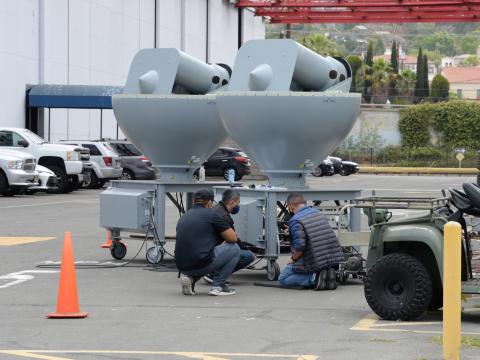Fiscal Armageddon Is No False Prophesy
West 2013 Online Show Daily, Day 1
Quote of the Day:“’Flat’ is the new ‘up’ in this defense budget environment.”— Robert O. Work, undersecretary of the Navy
The military services are facing potentially crippling constraints if sequestration takes place in March. Defense officials foresee the likelihood of draconian budget cuts being imposed that will cripple the force just as it is being counted on to assume new strategic missions. In most cases, the services will have to choose to sacrifice some capabilities so that others will remain part of the force. In worse-case scenarios, the U.S. military may be unable to meet its obligations when a crisis emerges.
These and other points were hammered home by speakers and panels on the first day of West 2013, the annual conference and exposition hosted by AFCEA and the U.S. Naval Institute in San Diego. While the event has the theme of “Pivot to the Pacific: What Are the Global Implications,” the first day’s discussions largely focused on the dire consequences of the fiscal cliff as well as potential solutions to avoid completely gutting the military force. Audiences generally were aware of the looming budget crisis, but many were surprised by the bluntness of the assessments offered by high-ranking Defense Department civilian and military leaders.
West 2013 Online Show Daily, Day 1
Quote of the Day:“’Flat’ is the new ‘up’ in this defense budget environment.”— Robert O. Work, undersecretary of the Navy
The military services are facing potentially crippling constraints if sequestration takes place in March. Defense officials foresee the likelihood of draconian budget cuts being imposed that will cripple the force just as it is being counted on to assume new strategic missions. In most cases, the services will have to choose to sacrifice some capabilities so that others will remain part of the force. In worse-case scenarios, the U.S. military may be unable to meet its obligations when a crisis emerges.
These and other points were hammered home by speakers and panels on the first day of West 2013, the annual conference and exposition hosted by AFCEA and the U.S. Naval Institute in San Diego. While the event has the theme of “Pivot to the Pacific: What Are the Global Implications,” the first day’s discussions largely focused on the dire consequences of the fiscal cliff as well as potential solutions to avoid completely gutting the military force. Audiences generally were aware of the looming budget crisis, but many were surprised by the bluntness of the assessments offered by high-ranking Defense Department civilian and military leaders.
The starkest assessment came from the first speaker, Adm. James A. Winnefeld Jr., USN, vice chairman of the Joint Chiefs of Staff. Speaking to a packed house at the morning keynote address, Adm. Winnefeld described the looming financial crisis as a “wolf,” and said it is becoming “increasingly apparent that this wolf is going to catch us.”
 Adm. James A. Winnefeld Jr., USN, vice chairman of the Joint Chiefs of Staff, gives a blunt assessment of the fiscal crisis facing the military during the morning keynote address at West 2013.
Adm. James A. Winnefeld Jr., USN, vice chairman of the Joint Chiefs of Staff, gives a blunt assessment of the fiscal crisis facing the military during the morning keynote address at West 2013.Planners will be faced with two unpleasant choices: either the military will become smaller as a result of politically driven choices, or it will not be allowed to become smaller—in which case readiness will suffer to the point of having a hollow force. Ultimately, the U.S. military may be so weakened that someday it may be asked to respond to a crisis, and it may have to say that it cannot.
That concern about a hollow force was echoed by several other speakers throughout the day. Robert O. Work, undersecretary of the Navy, warned in the luncheon keynote address, “If we have sequestration, we will have a hollow force by the end of the year.” Kori Schake, a research fellow at the Hoover Institution, offered her own blunt assessment. “If the clock is ticking, then the bomb is about to go off.”
Schake pulled no punches in describing the gravity of the situation as well as assessing blame. The Defense Department “has been in denial for months that this was going to happen,” she charged, noting that the administration and the defense leadership made a set of choices that has aggravated it. As a result, the defense community is in for a decade of austerity that will be immutable.
Work stated that “’Flat’ is the new ‘up’ in this defense budget environment.” Looking at the Navy budget, he quipped “we have an average budget … lower than last year, higher than next year.
Vice Adm. David H. Buss, USN, commander, naval air forces, U.S. Pacific Fleet, warned against cuts in readiness. “If we’re taking money out of the readiness accounts, the output out the back end will be less than today—that’s at the tactical level.” He added that, at the strategic level, the United States may not be able to map down to reach the tactical level.
Among these gloomy presentations were some suggestions to minimize the damage caused by sequestration cuts. Adm. Winnefeld offered that force priorities should be shaped around national security concerns, and planners are using a list of criteria for selecting which capabilities and assets are kept. These criteria include elements for ensuring the survival of the nation; ensuring the security of the global economic structure; preventing catastrophic attacks on the United States; protecting allies; protecting Americans abroad; and protecting universal values. The best chance for the military to acquire or keep assets that it considers important will be if those assets represent several of these criteria, the admiral emphasized.
Schake called for the Defense Department to develop a budget across the decade that is consistent with the sequestration. That will buy time to realize saving and cost reductions over time, instead of all at once—which is what the department is facing now.
 Lt. Gen. John A. Toolan Jr., USMC, commanding general, I Marine Expeditionary Force (l), discusses the fiscal crisis with fellow panelists (l-r) Vice Adm. David H. Buss, USN, commander, naval air forces, U.S. Pacific Fleet; Vice Adm. Thomas H. Copeman III, USN, commander, naval surface forces, U.S. Pacific Fleet; and panel moderator Bradley Peniston, editor, Armed Forces Journal.
Lt. Gen. John A. Toolan Jr., USMC, commanding general, I Marine Expeditionary Force (l), discusses the fiscal crisis with fellow panelists (l-r) Vice Adm. David H. Buss, USN, commander, naval air forces, U.S. Pacific Fleet; Vice Adm. Thomas H. Copeman III, USN, commander, naval surface forces, U.S. Pacific Fleet; and panel moderator Bradley Peniston, editor, Armed Forces Journal.Adm. Winnefeld cited innovation as one potential solution. Existing hardware could be adapted for new missions and capabilities, which would mitigate losses elsewhere. He described how the littoral combat ship could be adapted for use in missions beyond those for which it originally was designed. The admiral also called for inexpensive, highly adaptive electronics pods for unmanned aerial vehicles.
Adm. Buss called for the integration of unmanned systems into naval aviation. When those systems are deployed on carriers, the effect will be a revolutionary jump start in technology, he predicted. He also stated that sequestration decisions made by the Navy should be reversible, if possible, so that the service could reconstitute capabilities should fiscal conditions or priorities change.
Lt. Gen. John A. Toolan Jr., USMC, commanding general, I Marine Expeditionary Force, suggested that a return to pre-war procedures may help realize significant savings. Noting that the country provided whatever warfighters requested over the past 10 years, he offered that the military had lost “acquisition discipline.” A return to that discipline could generate savings that would help mitigate the effects of cuts.>
And at least one area may see increases in funding. Undersecretary Work described cyber as one element that will continue to experience growth. The Navy is increasing funding for cyber security and cyber forces, and these will become even more important as others are cut back.
Coming up on the second day of West 2013: A morning keynote address by Cecil D. Haney, USN; a luncheon addressby John Smart, president of the Acceleration Studies Foundation; and three panel discussions ranging from personnel retention to cyber security.



